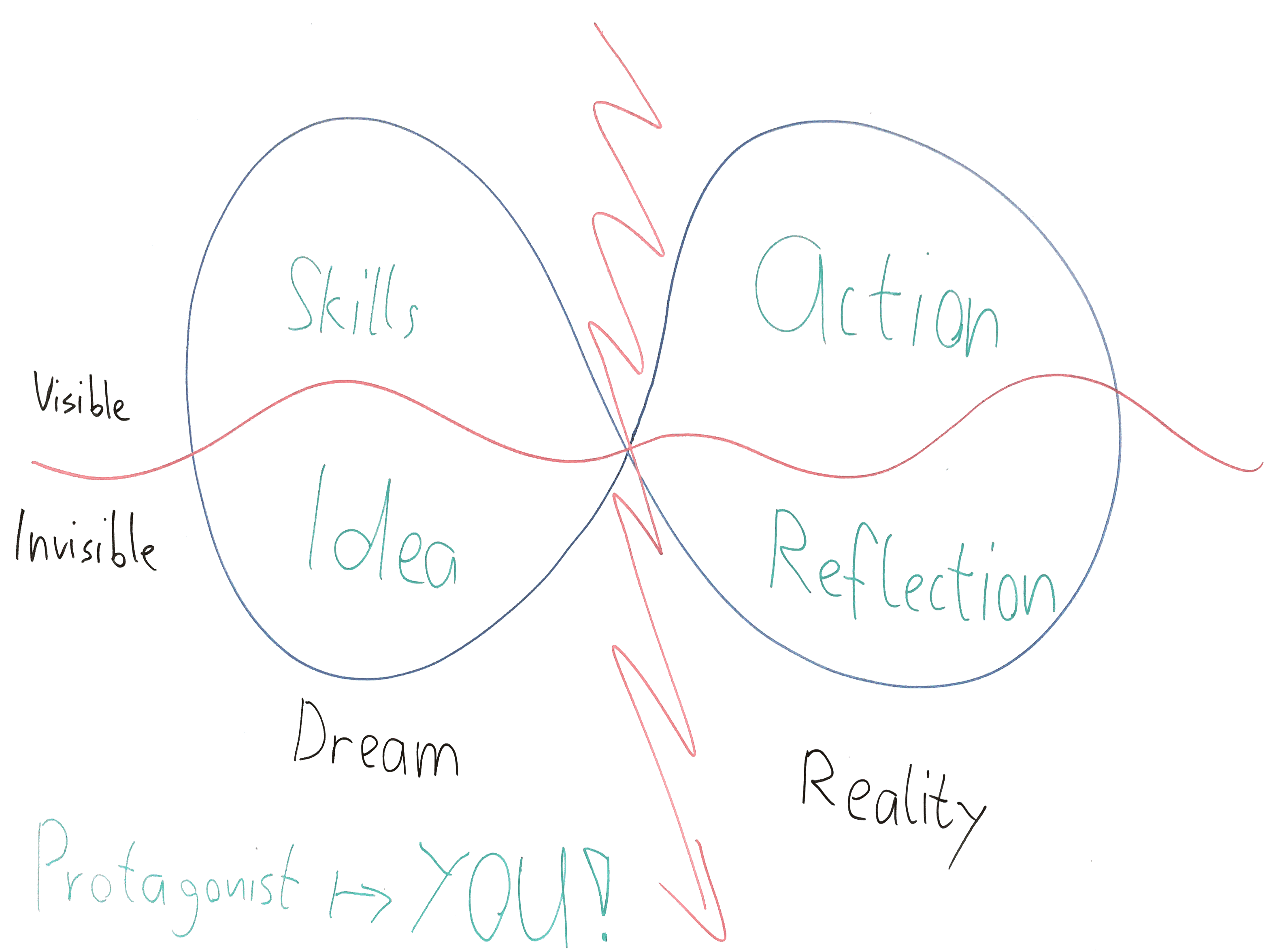We are masters of lying to ourselves when it comes to making our dreams happen. Most everybody has an aspiration or an idea that is not directly tangent to the professional path they chose. How often do we make them happen? Even the ones we could easily accomplish? We classically fail even at going for a run. I decided to investigate how we can make the jump from dream to reality – not for the Elon Musks amongst us but for the ordinary you and me, who may or may not have a meaningful impact on this world. For the future entrepreneurs that do not make the news but create all those jobs we’re so happy to have. For you – and for myself.
The Dream Reality Flow Model
Naturally, I developed a model based on which we can investigate how we are doing with our ideas, how others succeed or fail with theirs, what it takes to progress and how to perform a health check on our projects. Note that this doesn’t only apply to your world-altering masterplan but to the way you approach any project that you are serious about. For me, how I approach poetry is one. Could be a hobby for you or a long-repressed dream of making your creative talent a side gig. Find the model below.

As you can see, my approach treats dreams and ideas as infinite occurrences. You cannot execute a dream. It never stops and every idea evolves constantly. That is why the reflection phase is more of a bridge to the next iteration rather than the last step. I call it the Dream Reality Flow Model because things are aflux and you cannot ‘make it’ for good. What is ‘it’ anyway? You have an idea, you realise it – you had five more ideas in the meantime. You go for another one, and so on. To understand the concept fully, it is crucial to understand that the protagonist of your story is YOU. Not your dream. Not your idea. YOU. You may drop an idea at some point and your dreams evolve but YOU stay in the equation. This also indicates that you should view investments as investing in yourself rather than your venture!
I don’t think it makes sense to try and explain the model in a theoretical way. The only way that it can do something for you is if you understand it in such a way that is applicable and useful to your ideas and dreams. Let me try to do so in three iterations. This allows for bottom-up learning and every iteration bears an additional chance to gain understanding and for that ‘click’ moment to occur in your head.
Iteration 1 – Theory
Everything starts with an idea. It could be the realization that you haven’t been pursuing a life-long dream and want to change that. Could be that you realize you want to become a creative person. Maybe you just realize that you haven’t been making progress toward the goals you are already pursuing.
Progress can only happen when you are clear about what it is that you are pursuing. This requires you to spell it out. Can you formulate what it is you want to do in a sentence? Do you know what needs to happen for you to have succeeded? By the way, doing this in you head is not enough, it is below the surface and therefore not real. You have to externalise it. Can you defend your dream when talking to somebody else? It doesn’t matter whether they support you or share your enthusiasm for your idea but explaining yourself to somebody else makes a huge difference and you’ll see that your idea sounds a lot different out loud than it did in your head.
If you know – or you think you know – what you want, the next thing to consider is what skills you possess to make it happen. You can list them or just think about them. It helps to be brutally honest to yourself. What skills do I need and which do I possess? Don’t forget skill level. You may possess a skill but unless you are god-like it may still make sense to improve it. Define which skills you need to bring to what level to succeed or to get one step closer to fulfilling your dream.
Note that, so far, you have done nothing to actually make something happen. This was all in your head. You prepared yourself to take action but you have not taken a single step toward making anything happen yet. That’s what’s next. What specific actions are needed to bring you to where you want to be? You may want to think in junks if you are reaching for the stars. Break it down in ever smaller pieces until you have a chain of tasks that you think you can realistically accomplish. What you have is the action plan to bring you to the next plateau – and eventually to turning an idea into your reality. Then you start executing, one by one, junk by junk. It’s important that these tasks seem doable enough. That is how you make sure you don’t get stuck.
Once you reached the end of the action plan, you take a deep breath and celebrate. However small the success is, reward yourself. Take a moment to realize that you made something happen! There is no feeling more rewarding than having done what you wanted to do. Once you enjoyed your moment of self-love, it’s time to meditate on the situation. Are you where you want to be? What is better than before? What more needs to happen to get there? You get the idea. This is an infinite game. You will never really ‘get there’, because that would mean you have no more dreams and aspirations! This is also the link back to the idea phase. Reflection hopefully leads you to the next productive iteration. Cherish the fact that this is not a project but a process. It will never end and being able to embrace this has a major impact on the satisfaction we experience in life.
Iteration 2 – Coaching
So, let me provide you with a real example. I started taking steps toward my goal of becoming a self-employed coach last year. The dream had emerged from a tough self-finding phase after what could be called an increadibly early midlife crisis (or a spiritual awakening to mention the positive counterpart). Anyway, the phoenix that emerged from the ashes wants to help people solve their own problems – just the same thing that others did for me when I needed it. The strong belief emerged that everybody could use external help for one aspect of their lives or another. Usually several – I can instantly list half a dozen for myself. So, that was the aha moment. An idea was born. I will be a coach.
Except for a keen listening ability (that I used quite selectively up to last year), I had no real skills to show for. Certainly none that I could believably communicate. So, that was where I started. I enrolled in online courses in Life Coaching and Business Coaching. These wouldn’t be the end of the journey but I knew it was a start. It was measurable. There was no reason why I wouldn’t be able to do it. A clear action step.
In an exercise in the Business Coaching course, I was instructed to send mails to coaches and ask them a few questions. My first instinct was to skip the task. I already knew what coaching was, why bother? But then I remembered what I had told myself when I enrolled. ‘This time, this time I’ll do it properly!’ And so I wrote those mails. One coach replied that I could meet her. One thing led to another and an internship alongside multiple contacts in the field. It effectively kickstarted my pursuit of becoming a self-employed coach.
I guess this makes it very clear that reality is not linear. And yet the above describes an iteration as shown in the model. What follows is the reflection and another iteration. And another. I’m in for the long run and if you are, too, I’ll have much to offer you in the future. I hope this has brought you some more insight as to how the model can be used. Alright, let’s do another iteration.
Iteration 3 – Running a Marathon
For whatever reason you would want to run a marathon (maybe to test yourself?), let’s say you just realized that you let your physical health slip a bit and want to change. In order to make an effective change you set yourself the goal of running a marathon in say, a year. Now, that’s about as clear a formulation as you’ll ever get. But how to get there? Here, the skills are more connected to your will than any abilities. You need to practice consistently and cannot skip training sessions if you are to run that marathon.
What is the action you are going to take? Practice runs seem appropriate. You define your training plan. Say, you do 10k runs twice a week and one 20k run per week. This is going to be tough at first if you aren’t used to running but will become increasingly easier. The important part is to not get lost in the details of a plan (changing your whole nutrition etc.) but to actually go out there today for that first practice. Establish your routine and reflect on the progress you are making after a week, after two weeks, after a month. You may wish to alter the routes or change the distances per run to avoid boredom. Maybe the insights into the actual training routine make you want to change another thing or two. In any case, it starts now.
If it’s so simple, what’s so hard?
Nothing, we just tend to lose sight of things. Especially when there is a large gap between our current reality and our dream or realizing our idea, we tend to do nothing for lack of a starting point. That’s why junking works well. But it won’t work if we don’t possess the skills to make even the junks happen. Oftentimes, an action step only becomes easy if we have the right degree or experience. If we lack those, they become the goal of the current iteration. Remember, simplify it until all steps are easy.
It’s hard because the way is a long one for everybody with real ambition. Simplifying it to make the way realistic and allow ourselves to actually take those first baby steps may change everything. Make sure you don’t neglect the reflection because that is where all learning takes place. Based on the model, you can make little action plans with feasible, graspable, and measurable action steps that bring you right to the next reflection phase. Have fun on your next iteration!
Source header image: https://www.trendpro.co.ke/blogs/16-coming-up-with-great-business-ideas




I see what you mean. The steps, from the initial thought and idea of a project or a goal until the point of realizing it. Sometimes I find it helpful and motivating even, to recall how I felt when I succeeded at something or achieved a goal I had in mind. Then, I find the energy/force -whatever you wanna call it- to move to the next goal! 💪😎